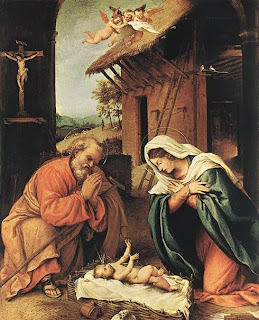
THE THREE MASSES OF CHRISTMAS
Brother John M. Samaha, S.M.
Our feast of Christmas came from a pagan observance which was Christianized. It is a pagan festival revisited. The first mention of the celebration of the Lord’s nativity in a liturgical calendar appears in the fourth century. This was the baptism of the pagan festival of the invincible sun (sol invictus), an observance introduced in 274 by the Emperor Aurelius (270-275), and celebrated in Rome on December 25, the winter solstice. The “Sun of Justice” (Mal 3:20) came as “the light of the world” (Jn 8:12) to vanquish darkness and to triumph over sin and death.
As the Christianization of the winter solstice, observed in Egypt and in Arabia on January 6, developed into the feast of the Epiphany, it became a major feast of the East. To counteract certain pagan myths, Epiphany, which means “showing forth” or “manifestation,” placed emphasis on the baptism of Jesus and his mission, and on the revelation of his glory at Cana? Gradually the feast of Epiphany spread to the entire West in the fourth century, and the East adopted the feast of Christmas about the same time.
In the fourth century at Rome the celebration of Christmas was a rather ordinary Mass celebrated by the pope. The Mass was similar to our present Mass at Dawn, and proclaimed the prologue of John’s Gospel. To refute and oppose the Arian heresy rampant at that time, the Mass affirmed and celebrated the Word made flesh. This Christmas Mass was clearly Christological and dogmatic in character, and in 360 mentioned the adoration of the magi and the massacre of the innocent children of Bethlehem.
At Bethlehem a night Mass was celebrated for Epiphany in the grotto of the Lord’s birth. Beginning in the fifth century a night Mass was celebrated in Rome also, but it was the Mass of Christmas and not that of Epiphany. The pope celebrated the night Mass at the Church of St. Mary Major, built after the Council of Ephesus. Wood from a crèche was displayed in one of the basilica’s chapels, and the Mass celebrated there became known as the Mass ad praesepe, that is, near the crèche. Since the account of Jesus’ birth at Bethlehem was read from the Gospel of Luke, the theme of this celebration was historical.
The Greek (Byzantine) colony in Rome celebrated December 25 too. They assembled at the Church of St. Anastasia (Holy Resurrection). To respect the Byzantines the pope celebrated Mass with them in the morning before going to St. Peter’s Basilica. In that Mass the gospel reading was the announcement of the good news to the shepherds found in Luke’s Gospel.
This is how the three Masses of Christmas originated. The pope and the faithful celebrated Mass at night at St. Mary Major, at dawn at St. Anastasia, and during the day at St. Peter.
- Used with permission.

Merry Christmas Esther!!!!
ReplyDeleteMerry Christmas Tracy!
ReplyDelete